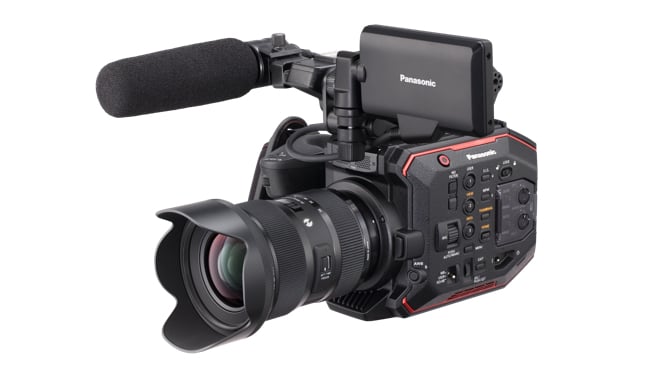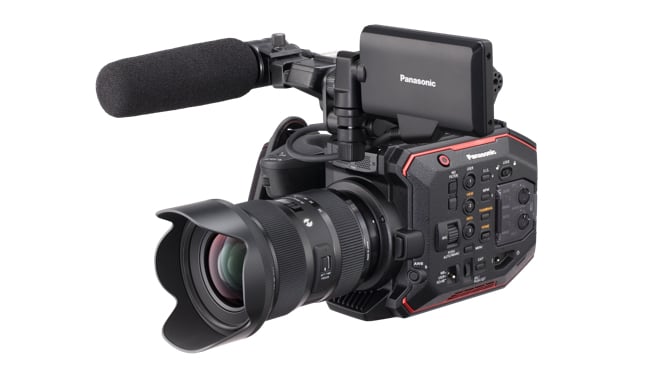
 The Panasonic EVA1: it's not 4K and it's definitely not 8K. But it all makes sense.
The Panasonic EVA1: it's not 4K and it's definitely not 8K. But it all makes sense.
At first glance, 5.7K seems a rather weird format for Panasonic to chose for its latest EVA1 camera. But it makes good sense to pack in a few more pixels whenever you can.
In one sense, Panasonic's release of a 5.7K camera is no surprise. It's more or less true to the current form of the market, competing more or less directly with things like the Sony FS range, as well as the cameras Blackmagic and Canon aim at both indie filmmakers and the more ambitious YouTube auteur. It's even roughly the same shape and size as many of those, and it pushes resolution up enough to seem usefully ahead of the pack.
Of course, we're all fairly clear by now – or we really should be – that resolution beyond 4K is useful for special purposes only. In this context, it's been speculated that the extra resolution is really there in order to ensure really excellent 4K pictures, and if so that's a very welcome development. It's not unusual for people to shoot 4K for an HD finish. 4K finishes, especially for TV, are becoming more common now that some of the video-on-demand networks require it, but it's still far from everyday, and downsampling helps everything. Sharpness increases, noise decreases and compression artefacts are reduced in visibility. Having a sensor the best part of 6K across means that we can get some of those advantages for 4K pictures, too.
A description of the resolution issues attending single-sensor cameras will be old news for some people, but it's worth being clear on exactly what we're talking about so we can properly understand why the extra resolution of the Panasonic is potentially so useful.
The concern is that a single-sensor camera must detect colour by filtering some of its pixels in red, some in green, and some in blue. Compare this to a three-chip colour camera such as those traditionally used for news and other TV broadcast work, where there's a red, green and blue detector for every pixel in the output video. The single-sensor camera must do a lot of processing work to create a complete red, green and blue record for every frame, which must necessarily involve interpolating – that is, mathematically making up – two thirds of the data.
Modern cameras do this carefully, using clever mathematics to do that interpolation, but it's a tricky thing to do well. The sensors usually have twice as many green pixels as they do red and blue pixels because the human eye is most sensitive to green light, and because it sees sharpness most acutely in the green. This works OK when shooting black and white subjects, as all three sets of colour-filtered photosites will see them, and we can resolve a lot of detail. Because the filters are generally somewhat desaturated, even fairly red objects will be seen, to a degree, by the green and blue-filtered photosites, but there's certainly a gradual resolution falloff as the subject becomes more and more saturated.
Shooting a red object against blue (as people do quite often with, say, bluescreen) can make the mathematics work hard to figure out where everything is supposed to be. Worse, as we discussed in our piece on aliasing and ways to avoid it we may have to optically blur the image quite a bit before it even hits the sensor in order to avoid problems with drawing thin lines.
The only reliable way to overcome these issues is more sensor resolution, which is probably a good reason (beyond sheer marketability) for Panasonic to have packed in a good few extra pixels. Scaling things down reduces the visibility of all these problems. It'll depend to some extent on how good the scaling in the cameras (good scaling is harder than it sounds) as well as the sort of scan modes that Panasonic have chosen to provide. All high-resolution cameras should have a centre-crop mode providing a small effective sensor for HD shooting, simply because the same camera can then excel at both formal drama and looser documentary styles. In full-beans mode, though, Panasonic camera is certainly likely to be very sharp, even within the field of 4K cameras which tend to be hungry for sharp, contrasty lenses in any case.
Those old Nikons might struggle to cope.
Tags: Production


Comments